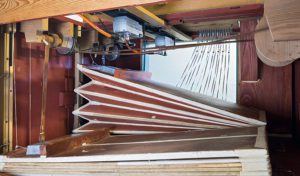Whether in the classic church setting or in modern rock music: the organ is the queen among musical instruments. It remains unequaled in its variety of sounds. While the sound is generated electronically on modern organs, air still sets the tone on the classic instruments. Instead of relying on human muscle, however, the arduous work of generating wind is assumed by machines.
 The sound of an organ is generated by its different sized pipes, through which a constant flow of air is blown. Either the sound is made (like with a recorder) by the air being blown through a narrow gap against a lip, the labium, or by means of a vibrating reed inside the pipe, as is familiar with clarinets.
The sound of an organ is generated by its different sized pipes, through which a constant flow of air is blown. Either the sound is made (like with a recorder) by the air being blown through a narrow gap against a lip, the labium, or by means of a vibrating reed inside the pipe, as is familiar with clarinets.
Until around 100 years ago, the compressed air required for this, the so-called organ wind, used to be generated by bellows that were operated with the feet. On large instruments, up to twelve people were needed for the job. Only with the emergence of electricity did organ building make increased use of electric bellows, which, compared to the foot-operated bellows, generated a very constant and quiet air flow. At the same time, however, it was always a challenge to design the electric wind generator in such a way that it could not be heard during quiet pieces of music either.
 Orgelautomation: Electric motors for driving bellows
Orgelautomation: Electric motors for driving bellows
When it comes to restoring old instruments, organ builders keep the historic bellows when possible to preserve the sound of the organ in its original form. Nevertheless, to generate the organ wind automatically electric motors move the bellows up and down in place of a human assistant. As was also the case with a historic specimen at the College of Catholic Church Music and Musical Education in Regensburg. In 1752, Antonio Pilotti made the organ in Bologna in typical Italian style. It was given an automatic bellows unit during its restoration.
 The brief for the Jörg Bente organ workshop was that the original historical function had to be preserved and that the organ should be fitted with neither a programmable logic controller (PLC) nor other control elements apart from the main switch. In collaboration with engineers from Festo, the decision was finally made to opt for EMMS-AS-70 series electric motors and a CMMP series controller to control the motors.
The brief for the Jörg Bente organ workshop was that the original historical function had to be preserved and that the organ should be fitted with neither a programmable logic controller (PLC) nor other control elements apart from the main switch. In collaboration with engineers from Festo, the decision was finally made to opt for EMMS-AS-70 series electric motors and a CMMP series controller to control the motors.
The wiring and layout of the controller allows for a quiet operation. The motor and controller also enables a dynamic switch between the breaks in playing with a low air consumption and full use with a high consumption of air. The required air pressure of 4.5 millibar remains constant, as one of the two bellows always retains enough reserve air.
The restored instrument with the automated bellows lifting unit has successfully been in action at the college premises in Regensburg since the end of July 2014. The organ has since been used in lessons for the authentic reproduction of Italian music from the 18th century.
Festo
www.festo.com


Leave a Reply
You must be logged in to post a comment.